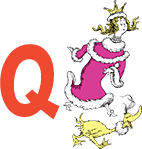
Quacking with Q
Rationale: This lesson will help children identify /q/, the phoneme represented by Q. Students will learn to recognize /q/ in spoken words by learning a meaningful representation (ducks quacking) and the letter symbol Q, practice finding /q/ in words, and apply phoneme awareness with /q/ in phonetic cue reading by distinguishing rhyming words from beginning letters.
Materials: Primary paper and pencil; chart with "Quincy Quail quietly stacked quarters for the queen"; drawing paper and crayons; Dr. Seuss's ABC (Random House, 1963); word cards with QUIT, QUICK,QUIZ, QUIET, QUILLS, and QUEST; assessment worksheet identifying pictures with /q/ (URL below).d
Procedures:
1. Say: Our written language is a secret code. The tricky part is learning what letters stand for—the mouth moves we make as we say words. Today we're going to work on spotting the mouth move /q/. We spell /q/ with letter Q. Q looks like a circle with a tail, and /q/ sounds like the beginning of a duck quacking.
2. Let's quack (“quack, quack, quack”). Now let’s say the beginning of quack (/q/, /q/, /q/) [Pantomime w/hand a duck beak quacking]. Notice what your lips are doing? (Making a little circle). When we say /q/, we blow air between our little circle in our lips and pull our tongue back while touching the roof of our mouth.
3. Let me show you how to find /q/ in the word squeak. I'm going to stretch squeakout in super slow motion and listen for my /q/ sound that was at the beginning of “quack”. Ss-qq-uu-ee-aa-k. Slower: Sss-q-q-q-e-e-e-a-a-kkk. There it was! I felt my air go between my little circle in my lips and my tongue pull back while touching the roof of my mouth. I can feel the /q/ from “quack”in “squeak”.
4. Let's try a tongue twister [on chart]. " Quincy Quail quietly stacked quarters for the queen." Everybody say it three times together. Now say it again, and this time, stretch the /q/ at the beginning of the words. " Q-q-q-quincy Q-q-q-q-quail q-q-q-quietly stacked q-q-q-quarters for the q-q-q-queen”. Try it again, and this time break it off the word: "/Q/uick /q/uail /q/uietly stacked /q/uarters for the /q/ueen.
5. [Have students take out primary paper and pencil]. We use letter Q to spell /q/. Capital Q looks like a big/tall circle with a tail on the bottom. Let's write the lowercase letter q. Start with a little circle. Then go to the right side of the little circle and go straight down. Then curve your line toward the sky once your line is a little longer. I want to see everybody's q’s. After I put a smile on it, I want you to make nine more just like it.
6. Call on students to answer and tell how they knew: Do you hear /q/ in quick or fun? quiet or toe? slippery or earthquake? kickor queen? Say: Let's see if you can spot the mouth move /q/ in some words. “Quack”with you hand if you hear /q/: Quinella stitched her quilt quickly for her quacking duck.
7. Say: "Let's look at an alphabet book. Dr. Seuss tells us about a silly queen with a funny pet!" Read page about Q, drawing out /q/. Ask children if they can think of other words with /q/. Ask them to make up a silly creature name like Quacking Quacker-oo, or Qually-Qumpit. Then have each student write their silly name with invented spelling and draw a picture of their silly creature. Display their work.
8. Show and model how to decide if it is quick or lick: The Q tells me quack with Q, /q/, so this word is qqq-uu-i-c-k, quick. You try some: QUAKE: quake or wake? QUIT: mit or quit? QUILT: tilt or quilt?
9. For assessment, distribute the worksheet. Students are to complete the partial spellings and color the pictures that begin with Q. Call students individually to read the phonetic cue words from step #8. (http://www.kidzone.ws/kindergarten/q-begins2.htm)
Reference:
“KidZone Preschool and Kindergarten Beginning Consonants Worksheets.” Worksheets for Kids, www.kidzone.ws/kindergarten/q-begins2.htm.
Seuss. Dr. Seuss's ABC. HarperCollins, 2017.
“Emergent Literacy Example.” Log In to Canvas, auburn.instructure.com/courses/1103232/assignments/6008324.
Murray, Bruce. The Reading Genie, www.auburn.edu/academic/education/reading_genie/.
E-Mail:
